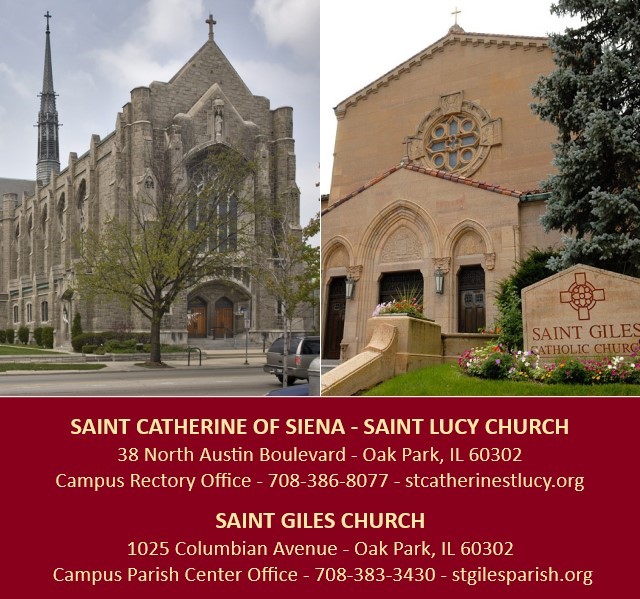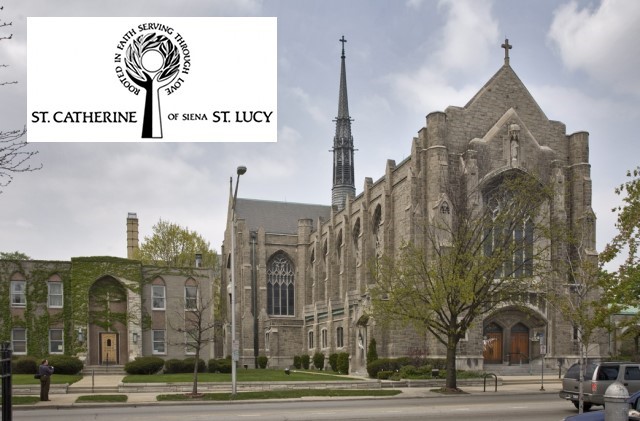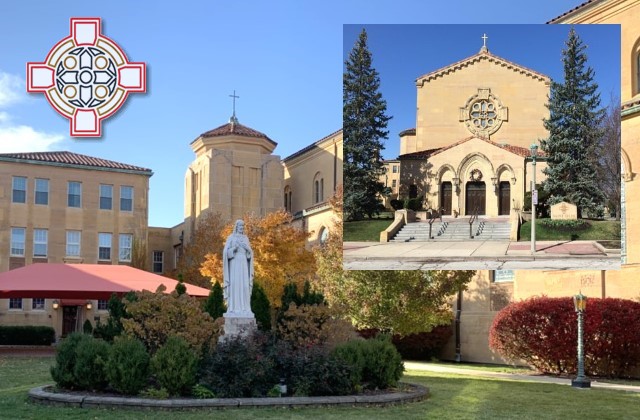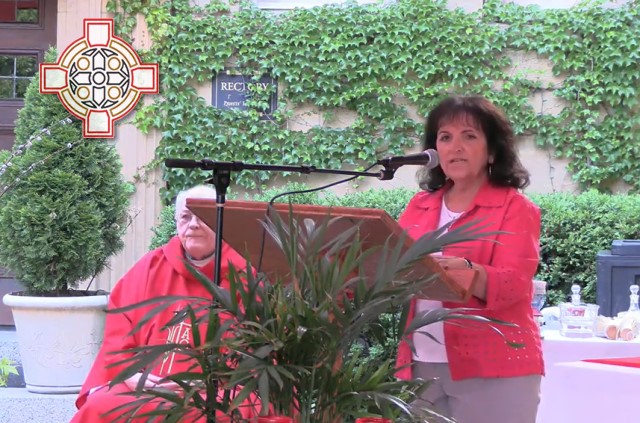
St. Catherine of Siena-St. Lucy and St. Giles Communities – The Paths we have trod, the Gifts that we bring!
Our new parish combines three vibrant communities, each with a faith-filled history. We will be capturing a few highlights on this page, which we hope will whet your appetite to learn more about each other, the church buildings we share, and the values we treasure. As a pilgrim church, we celebrate the paths of our past as we move ahead in a new stage of our journey together.

St. Catherine of Siena-St. Lucy Community
Mission Statement
We, the parishioners of St. Catherine of Siena-St. Lucy Parish, seek to deepen our relationship with God and to celebrate God’s presence in Word and Sacrament.
By accepting all into our family, we seek unity in Christ and seek to proclaim His Good News in the Discipleship of our lives.
History
The St. Catherine-St. Lucy community has approximately 285 member households, blending the city and suburbs, drawing from the west side neighborhoods of Chicago, Oak Park, River Forest, and beyond.
St. Catherine-St. Lucy is known for its diversity and for welcoming parishioners from different backgrounds, including different ethnicities, socioeconomic levels, and sexual orientations, among other characteristics. Parish members take pride in their identity as an integrated community. A high point of the year is an African American Heritage Celebration each February. St. Catherine-St. Lucy has had a Gospel Choir for more than 30 years under the direction of Julius White. This choir along with the Celebration Choir reflects the rich diversity of cultural and spiritual praise.
There have also been many significant “firsts” in the history of the St. Catherine-St. Lucy Community. The parish was the first in the diocese to hire a female lay staff person. The parish also was a leader in the designation of a female homilist, Sister Teresita Weind. Sister joined the parish in the 1970s, and her spiritual gifts were quickly recognized by Father Carolan and the parishioners. She became more involved with religious services as she shepherded future Catholics through preparation for Baptism at Easter liturgy. Another unique initiative, called Faith & Fellowship, is a ministry that unites people with mental illness and other parishioners in a shared sense of community.
In 1974, St. Catherine of Siena Parish, founded in 1889 as the first Catholic parish established in Oak Park, merged with St. Lucy Parish founded in 1911 in the Austin neighborhood on Chicago’s West Side. Together they formed the renamed St. Catherine of Siena–St. Lucy Parish. Although the transition was difficult at times, the leadership of Father Carolan helped parishioners to bridge cultural differences and work through racial divides. This experience laid the foundation for St. Catherine-St. Lucy to become the welcoming and inclusive community that it is today. The logo was originally designed to reflect the diversity of the parish: black, white, Chicago, and Oak Park joined together as one with the Holy Spirit. It was redesigned ten years later to show how the parish had grown together as one, reaching to embrace the Spirit. “Rooted in Faith, Serving Through Love.” The two parishes have a history that is intertwined.
St. Catherine Parish was originally established on the west side of Chicago in 1889 at the request of area residents. The first Mass was offered by Father Louis Campbell on Christmas day in an unfinished frame church at Mayfield and Washington Streets.
As the population of the area grew the St. Catherine Parish established several outreach churches or “missions,” the first of which was Our Lady Help of Christians at Chicago and Cicero. In 1897, another mission was founded in the town of Cicero: St. Attracta. Eventually, six additional parishes were created from St. Catherine of Siena. One of these parishes started as a second location of St. Catherine Parish. In 1911, this became St. Lucy Church and Parish at Lake and Mayfield Streets.
Sadly, St. Catherine Church at Washington and Mayfield Streets burned to the foundation in March 1917. Fortunately, construction had begun on a combination school and church on Austin Boulevard in 1916, which was completed in September 1917. The church was on the first floor and a school on the second floor. A third floor was added in 1932.
In November 1930 ground was broken for what later became St. Catherine of Siena-St. Lucy Church. It is a Tudor-Gothic style church designed by Joseph W. McCarthy, architect for the archdiocese. He designed 43 churches and 4 cathedrals. He designed the parish school, rectory, Maguire Hall, and the convent. He also designed St. Giles and St. Luke Churches. The convent building was later renamed Lucienne House to welcome St. Lucy parishioners. This building is now occupied by a not-for-profit group helping women recovering from addiction.
The church includes a baptismal chapel on the northeast side, as well as a small chapel for daily Mass on the northwest side. There is a music room on the first floor as well as a large choir loft. The organ was installed in 1932. It is a Casavant Freres Ltee Organ created in Saint-Hyacinthe, Quebec, Canada. The organ is Opus number 1467 and consists of 1,641 pipes. It is part of the Organ Historical Society Pipe Organ Database, the only Oak Park Catholic Church included in this database. It was exhibited by the Historical Society in its 2012 convention.
The roots of the St. Catherine of Siena-St. Lucy School go back to the summer of 1885, six years after the founding of St. Catherine of Siena Parish. The Sisters of Mercy opened St. Catherine’s Academy, the first Catholic grammar school in Austin, to serve families of a growing parish. By 1912, advanced branches of learning were taught to Catholic children from nine Austin and Oak Park parishes.
In 1917, in the period when St. Catherine Parish had two locations, a new church and school building was dedicated at Lake and Mayfield Streets. The Sisters of Mercy organized a grammar school at the new location. Services were held on the lower floor, and classes attended on the upper. In 1934, a third floor was added to the school to accommodate classrooms with an attic gymnasium above. In 1959 the School Annex, now known as Maguire Hall, was built as a combination gymnasium and assembly hall for students.
In 1974, when St. Lucy and St. Catherine parishes merged, a new school was born: St. Catherine of Siena-St. Lucy School. The school has evolved and grown over the years into an academic and religious institution that is the pride of the community, serving more than 250 students ranging in age from early childhood to eighth grade.

St. Giles Parish Community
History
Throughout its 95-year history, countless men, women, and children have been introduced to the faith, celebrated the sacraments, and found friendships and encouragement within the community of St. Giles. The beautiful campus of St. Giles Church reflects a history of prayerful and financial support of the Catholic parishioners and the leadership of its pastors. Today, more than 2,020 households make up the parish, including families in nearby areas of Chicago and suburbs.
In 1927, a new parish was established to form community among the many Catholic families that were building homes and settling in the largely undeveloped area west of Chicago, in the village of Oak Park. The Kelly farm was purchased for construction of a church at the urging of Cardinal Mundelein. Meanwhile, families gathered for Mass at the Reedy home at 1005 N. Kenilworth Avenue. A portable building from Sears Roebuck was erected on Greenfield Street between Linden and Colombian Streets. Three hundred people attended the first Mass in this frame building on August 7, 1927.
In short order, a new building was constructed of soft-hued Mankato stone for the exterior, with a church on the first floor that had space for 600 and second floor for a school. This is the Frawley Building today. The school was under the direction of the Sinsinawa Dominican Sisters, who commuted from Rosary College by cab. Later a nearby residence was purchased for them. As the student population grew, there were more Sisters needed to teach them; so, in 1933 a convent was built with matching Mankato stone.
In 1938, as the parish continued to grow, plans were made for a new church. Early on, the parishioners decided to replace a temporary roof with a permanent structure and to seek fittings that were suited to the elegant design. Marbles from Europe and Africa were chosen for the sanctuary, shrines, and altar. Due to delays caused by World War II, the church could not be completed and dedicated until 1950.
As the Oak Park area continued to grow, with Catholic families desiring to send their children to the parish school, there was a pressing need for more classrooms. In 1952, construction began on a building to include classrooms and a gym. In 1954 this was dedicated, becoming the Corrigan Building. Yet another school building, the Gleeson Building, was completed in 1960. A second floor to this building was added in 1983 as the Guild Hall, renamed McDonough Hall in 1989. This important gathering space in our community today was named after the dedicated service of the parish’s third pastor, Father Thomas McDonough, just as the other major buildings were named after pastors Father Joseph Corrigan, Father James Gleeson, and Father Lawrence Frawley.
Over the years, parishioners raised funds in a series of capital campaigns to maintain and improve these facilities. A three-year campaign, begun in 1989, raised more than $750,000 to restore the buildings that were showing their age by then. This was followed by other campaigns up to the most recent begun in 2018. Generous donations to these campaigns and other major gifts have enabled essential maintenance and restoration of church and school facilities. Other major gifts provided for the restoration of the plasterwork on the church and the exquisite stained-glass windows.
In 1994, Father Thomas Dore, the parish’s fifth pastor, initiated the Stewardship Way of Life campaign to establish the parish on a foundation of faith as members of the Household of God. Parishioners responded to this call to share generously of their time and talents as well as their financial treasure. In the summer of 2000 as the 75th anniversary of the church approached, nearly 400 parishioners gathered to share their hopes and dreams in a process called SOLAR (Summer of Listening and Reflecting). Many ideas regarding ministries, programs, staff, facilities, and finance emerged.
Action plans from SOLAR were begun and are still ongoing. The former convent building became the Dore Parish Center. In addition, a comprehensive leadership structure was formed. In 2014, Father Carl Morello, the sixth parish pastor, established a Parish Strategic Planning Committee to work with the Parish Council in developing a five-year plan, Vision 2020, which continues to guide efforts today.
The parish school has always been an important source of spiritual and social unity in the parish. Since the school opened its doors in 1928, its singular commitment has never wavered: preparing children to be people of faith imbued with a lifelong love of learning and spirit of service to others. For more than 90 years, St. Giles School has served the families of Oak Park, Elmwood Park, Galewood and surrounding neighborhoods. A dedicated and dynamic faculty is committed to educational excellence for preschool through eighth graders. As they explore a rigorous interdisciplinary curriculum, spirited students burst with pride in being a St. Giles Lion in support of the sports teams. Inspiring learning environments feature the latest technology to drive academic advancement.
Over the years, St. Giles parishioners and their pastors have developed a wide array of ministries and other spiritual and social activities. Ministries devoted to liturgy, Bible study, centering prayer, and shared spiritual reading have fostered spiritual development. Other groups have built community through social ties, such as the Men’s Society and the Council of Catholic Women, as well as the youth ministry called CHAOS, which is a collaboration with other Oak Park-area parishes. Some activities have grown out of the needs of the wider community, such as food collections and a prayer shawl ministry. Many other ministries and activities have enabled St. Giles to form a strong community of Christians and friends.

St. Giles Family Mass Community
About 200 households make up the St. Giles Family Mass Community, an intentional community within the St. Giles Parish. This community has a strong emphasis on full participation in Eucharistic liturgy, Vatican II principles of lay leadership, and incorporation of children and families in liturgical celebrations.
History and Values
In 1971, a group of families requested permission from the pastor of St. Giles Parish to hold liturgy in the school gym to create a more intimate setting for Eucharist for their children and themselves, and to celebrate by participating more fully in liturgy as encouraged by Vatican II. Permission was granted with the understanding that because of limited parish resources, the group would have to be self-supporting, and the parish could not provide a priest-presider. From that simple beginning the group grew to be a distinct community within the wider parish with the ongoing support and approval of pastors and bishops. Father Carl is pastor of this community and a welcome presence as presider at Mass at least monthly. On other occasions, priests from Catholic Theological Union often preside.
Core values of the Family Mass are expressed in the life of this community.
“We Value Eucharist” – Some 30 individuals – adults and children – are engaged in preparing for and ministering at each Sunday Mass. Rotating teams of 8-10 meet in homes a week or two before each liturgy to reflect on and prepare the Scripture readings. These teams designate roles within the liturgy from handwasher and Gospel candle holder, to plate holders for Eucharist, and Scripture readers. Teams join with other members in the many tasks that transform the school gym into a beautiful, sacred environment to celebrate the Eucharist each week. In summer months, liturgy is celebrated at McDonough Hall or in the church courtyard.
“We value community” – By gathering in one place at the same time each week this community experiences a strong sense of connection as members of the family of God. The intimacy and informality of these connections enables members to share deeply in one another’s lives and to be supported and challenged to live lives of Christian discipleship. The willingness of so many to do the work of organization and ministry demonstrates the strong commitment of members. Programs of spiritual, liturgical, catechetical, social, financial, and social justice have grown organically from these roots.
“We rejoice in diversity” – Every person found in the community is celebrated, from the newborn welcomed in baptism, through the couples celebrating their 50th wedding anniversary, to those accompanied on their final journeys. The community is enriched by diversity of gender, age, race, talent, ethnicity, temperament, gifts, and ideas. Women are especially encouraged to share their spiritual gifts in various leadership and liturgical roles. The community especially enjoys the cultural exchange brought by a significant number of members with Guatemalan heritage. Each January, a celebration of Cristo Negro, the Black Christ of Esquipulas, brings a burst of colorful traditional dresses and deepened spiritual devotion. This liturgy is sometimes enhanced by the talents of a marimba band. Songs in Spanish are interwoven in music ministry through the year.
“We value formation and discipleship” – The founding members of Family Mass wanted spiritual formation for their children to be an integral part of the community’s life. In 1975, they brought the Catechesis of the Good Shepherd to the United States, which is a child-centered approach for religious formation based on Scripture and the image of Jesus as the Good Shepherd who calls each of us by name. This program continues today in collaboration with the larger St. Giles Parish community.
One of the foundational experiences of community and faith sharing for adults in the Family Mass is the liturgy preparation meeting in preparation for the celebration of the Eucharist. Through reflection on the Sunday Scripture, members explore how they can live lives centered in Christ. Over 75 percent of households participate in liturgy preparation teams two or more times each year.
“We value outreach and social justice” – A commitment to social justice was in the bones of the founding members and remains a vibrant thread. At various times, the community has united around support and housing for immigrants, outreach to prisoners and their families, education of those needing supplemental tutoring, and other initiatives. Most recently, support was provided to 18 area families who were in financial need due to illness and lack of employment during the Covid crisis.
“We value autonomy” – While established within the St. Giles Parish community and grateful for the Father Carl’s pastoral support, the Family Mass strives to maintain its tradition of lay leadership. The community is guided by three primary groups: Coordinating Board, Pastoral Team, and Liturgy Round Table. Major decisions and budgets are approved by vote at Town Hall meetings, open to all Family Mass community members.
“We are prayerful” – While the Eucharist is the primary source of spiritual nourishment in this community, there are many other spiritual practices that are part of the individual and communal lives of Family Mass members. In a recent survey, nearly three-quarters report regular spiritual practices such as morning and evening prayer, meditation and Centering Prayer, spiritual reading alone or in small groups, or praying the rosary. One third read Scripture at least once a month in addition to the team meetings in preparation for Sunday liturgy.
Continuing Evolution
At a recent Family Mass gathering to examine the Past-Present-Future, the 55 members participating confirmed the basic values of their founding documents while expressing a desire to revisit these principles and ensure that these are relevant to God’s intentions today. There was an emphasis on “healing contact,” a phrase in one of the founding documents. Other words often repeated were “invitation,” “welcome,” and “listen.” In this spirit, the meeting concluded with a favorite hymn in the community: “All Are Welcome!





















